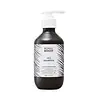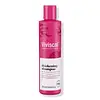What's inside
What's inside
 Key Ingredients
Key Ingredients

 Benefits
Benefits

 Concerns
Concerns

 Ingredients Side-by-side
Ingredients Side-by-side

Aloe Barbadensis Leaf Juice
Skin ConditioningSodium Methyl Cocoyl Taurate
CleansingCocamidopropyl Betaine
CleansingDecyl Glucoside
CleansingCoco-Glucoside
CleansingGlyceryl Oleate
EmollientPropanediol
SolventHydrolyzed Quinoa
Skin ConditioningPolyquaternium-10
Potassium Sorbate
PreservativeOlea Europaea Fruit Oil
MaskingMentha Piperita Oil
MaskingHippophae Rhamnoides Fruit Oil
Skin ProtectingMentha Arvensis Callus Lysate
AntioxidantHydrolyzed Jojoba Esters
Skin ConditioningLinum Usitatissimum Seed Oil
PerfumingSqualane
EmollientHelianthus Annuus Seed Oil
EmollientMacadamia Ternifolia Seed Oil
EmollientRosmarinus Officinalis Leaf Extract
AntimicrobialSerenoa Serrulata Fruit Extract
Skin ConditioningHibiscus Sabdariffa Flower Extract
Skin ConditioningHylocereus Undatus Fruit Extract
Skin ConditioningUrtica Dioica Leaf Extract
Skin ConditioningEquisetum Arvense Leaf Extract
AstringentChamomilla Recutita Flower Extract
MaskingPentylene Glycol
Skin ConditioningCaprylyl Glycol
EmollientEthylhexylglycerin
Skin ConditioningCitric Acid
BufferingAloe Barbadensis Leaf Juice, Sodium Methyl Cocoyl Taurate, Cocamidopropyl Betaine, Decyl Glucoside, Coco-Glucoside, Glyceryl Oleate, Propanediol, Hydrolyzed Quinoa, Polyquaternium-10, Potassium Sorbate, Olea Europaea Fruit Oil, Mentha Piperita Oil, Hippophae Rhamnoides Fruit Oil, Mentha Arvensis Callus Lysate, Hydrolyzed Jojoba Esters, Linum Usitatissimum Seed Oil, Squalane, Helianthus Annuus Seed Oil, Macadamia Ternifolia Seed Oil, Rosmarinus Officinalis Leaf Extract, Serenoa Serrulata Fruit Extract, Hibiscus Sabdariffa Flower Extract, Hylocereus Undatus Fruit Extract, Urtica Dioica Leaf Extract, Equisetum Arvense Leaf Extract, Chamomilla Recutita Flower Extract, Pentylene Glycol, Caprylyl Glycol, Ethylhexylglycerin, Citric Acid
Water
Skin ConditioningAmmonium Lauryl Sulfate
CleansingCocamidopropyl Betaine
CleansingCaprylyl/Capryl Glucoside
CleansingGlycerin
HumectantParfum
MaskingGlycol Distearate
EmollientSodium Benzoate
MaskingCitric Acid
BufferingLauryl Glucoside
CleansingLaureth-7 Citrate
CleansingLaureth-4
EmulsifyingPiroctone Olamine
PreservativePanthenol
Skin ConditioningPolyquaternium-10
Soluble Collagen
HumectantHydrolyzed Keratin
HumectantTrisodium Ethylenediamine Disuccinate
Chondrus Crispus Extract
Skin ConditioningFucus Vesiculosus Extract
EmollientLaminaria Digitata Extract
Skin ProtectingMaris Sal
Skin ConditioningFormic Acid
PreservativeLeuconostoc/Radish Root Ferment Filtrate
AntimicrobialBiotin
AntiseborrhoeicPhenoxyethanol
PreservativePotassium Sorbate
PreservativeLinalool
PerfumingHexyl Cinnamal
PerfumingLimonene
PerfumingCitronellol
PerfumingWater, Ammonium Lauryl Sulfate, Cocamidopropyl Betaine, Caprylyl/Capryl Glucoside, Glycerin, Parfum, Glycol Distearate, Sodium Benzoate, Citric Acid, Lauryl Glucoside, Laureth-7 Citrate, Laureth-4, Piroctone Olamine, Panthenol, Polyquaternium-10, Soluble Collagen, Hydrolyzed Keratin, Trisodium Ethylenediamine Disuccinate, Chondrus Crispus Extract, Fucus Vesiculosus Extract, Laminaria Digitata Extract, Maris Sal, Formic Acid, Leuconostoc/Radish Root Ferment Filtrate, Biotin, Phenoxyethanol, Potassium Sorbate, Linalool, Hexyl Cinnamal, Limonene, Citronellol
Ingredients Explained
These ingredients are found in both products.
Ingredients higher up in an ingredient list are typically present in a larger amount.
Citric Acid is an alpha hydroxy acid (AHA) naturally found in citrus fruits like oranges, lemons, and limes.
Like other AHAs, citric acid can exfoliate skin by breaking down the bonds that hold dead skin cells together. This helps reveal smoother and brighter skin underneath.
However, this exfoliating effect only happens at high concentrations (20%) which can be hard to find in cosmetic products.
Due to this, citric acid is usually included in small amounts as a pH adjuster. This helps keep products slightly more acidic and compatible with skin's natural pH.
In skincare formulas, citric acid can:
While it can provide some skin benefits, research shows lactic acid and glycolic acid are generally more effective and less irritating exfoliants.
Most citric acid used in skincare today is made by fermenting sugars (usually from molasses). This synthetic version is identical to the natural citrus form but easier to stabilize and use in formulations.
Read more about some other popular AHA's here:
Learn more about Citric AcidCocamidopropyl Betaine is a fatty acid created by mixing similar compounds in coconut oil and dimethylaminopropylamine, a compound with two amino groups.
This ingredient is a surfactant and cleanser. It helps gather the dirt, pollutants, and other impurities in your skin to be washed away. It also helps thicken a product and make the texture more creamy.
Being created from coconut oil means Cocamidopropyl Betaine is hydrating for the skin.
While Cocamidopropyl Betaine was believed to be an allergen, a study from 2012 disproved this. It found two compounds in unpure Cocamidopropyl Betaine to be the irritants: aminoamide and 3-dimethylaminopropylamine. High-grade and pure Cocamidopropyl Betaine did not induce allergic reactions during this study.
Learn more about Cocamidopropyl BetainePolyquaternium-10 is an ammonium salt of hydroxyethylcellulose. It is a white and granular powder used as a film-former and anti-static agent.
This ingredient is commonly found in hair conditioning products. According to a manufacturer, its positive charge makes it great for absorbing hair proteins. The manufacturer also states this ingredient helps with curl retention.
For haircare friends: this ingredient is not a silicone.
Learn more about Polyquaternium-10Potassium Sorbate is a preservative used to prevent yeast and mold in products. It is commonly found in both cosmetic and food products.
This ingredient comes from potassium salt derived from sorbic acid. Sorbic acid is a natural antibiotic and effective against fungus.
Both potassium sorbate and sorbic acid can be found in baked goods, cheeses, dried meats, dried fruit, ice cream, pickles, wine, yogurt, and more.
You'll often find this ingredient used with other preservatives.
Learn more about Potassium Sorbate